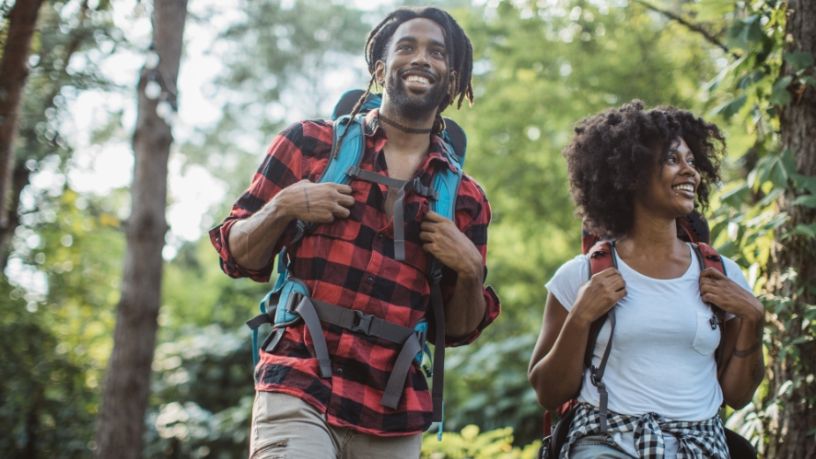On this page
Key takeaways
- Breathing exercises can help reduce stress and anxiety by slowing the breath and helping to lower blood pressure and pulse rate.
- Even in times of high stress, breathwork can help to bring us back into the present moment and retain a sense of calm.
- Many breath work exercises can be done almost anywhere, meaning you can use them ahead of a stressful meeting, during a presentation or if you’re feeling panicked or stressed.
Despite the fact that we breathe all day, every day, even when we’re asleep, we rarely think about it. Yet it’s one of our most useful ways to destress.
Different ways of breathing and breath work have been shown to have multiple physical and mental health benefits. Better yet, breath work can be done quickly and almost anywhere, making it one of the most accessible self-regulation tools we have.
From easing symptoms of panic to increasing calm and focus, knowing more about how to use your breath can support overall wellbeing and productivity.
How does breathing help reduce stress and anxiety?
Deliberate and focused breathing can help soothe your body during times of stress and anxiety by kick-starting your body’s ‘rest and digest’ system and reducing the effects of the fight or flight response.
But how?
When we're stressed or panicked, our central nervous system responds by flooding our bodies with chemicals like cortisol and adrenaline that can help us run away or fight, often called the ‘fight or flight’ response.
These chemicals can increase our heart rate, make us feel sick and shaky and cause our breath to be quicker or shallower.
On the flip side, focused breathing can help to combat these symptoms by helping to slow our breath, lower our heart rate and increase a sense of calm.1
In clinical practice, breath work has been shown to improve symptoms of:2
- Stress
- Anxiety
- Depression
- Trauma
- Addiction
- Obsessions
- Compulsions
- Inattention.
5 breathing exercises to reduce stress and anxiety
Some breathing exercises require you to lie down, close your eyes, and breathe so that you can hear your breath. Others you can do on the train during a morning commute or even in a crowded elevator; no one would be able to tell.
Whatever exercise appeals most to you, take a moment to sit, lie or stand as comfortably as you can and avoid distractions, such as talking to someone else, or looking at a phone or the TV. Try to focus completely on your breath.
During breath work you may notice your mind wandering, and that’s OK. Just bring your focus back to your breath as soon as you can. You may have to bring your attention back once, twice or even 20 times. Just keep practising and it will feel more natural in time.
The following breathing techniques can help you manage stress. Everybody is different, so try each one to find out what works for you.
1. Box breathing
Good for3: Doing anywhere to help lower blood pressure and reduce symptoms of anxiety
- Stand, sit or lie comfortably.
- Breathe in for 4 counts, filling your lungs with air.
- Hold your breath for the next 4 counts.
- Exhale from the nose or mouth for 4 counts.
- Hold for the final 4 counts.
- Repeat this cycle as many times as you need to.
2. The point of stillness
Good for: During a crowded commute, in a stressful meeting, preparing for a difficult conversation
- Sit or stand comfortably and focus on how you’re breathing.
- Notice the journey of each breath, moving in and out of your body. See if you can follow this journey for a little while.
- When it feels right, begin to focus on the pause at the end of each exhale, before the next inhale begins. There’s no need to alter the length of this pause, also called the ‘point of stillness’, a small space of quiet and rest which you can learn to appreciate.
- Do this for as long as you can, focusing purely on your breath.
3. The 3-part breathing technique
Good for4: A quick exercise that can improve calm and aid sleep
- Breathe in for a deep intake of air.
- Breathe out, emptying your lungs fully.
- Repeat, but on the next exhale, lengthen it so it's twice as long as the inhale.
4. Oceanic breathing
Good for5: Stress management and improved concentration
- With this exercise, you’re aiming to create an ocean sound in the back of your throat, so choose a private place where you won’t be disturbed.
- Close your mouth and breathe in and out through the nostrils, keeping your breaths regular and equal in duration.
- Gently place your tongue on the roof of your mouth to slightly narrow and constrict your throat. Be careful not to tense up too much, you should still feel comfortable and relaxed.
- Begin to take deeper breaths and notice the ocean sound being created by your breath in the throat.
5. Diaphragmatic breathing
Good for4: Moments of high stress when you need to slow your breath
- Lie on your back or sit in a chair.
- Place one hand flat against your chest and the other on your stomach.
- Take slow, deep breaths through your nose, keeping the hand on your chest still as the hand on your stomach rises and falls with your breaths.
- Next, breathe slowly through pursed lips.
- Eventually, you want to be able to breathe in and out without your chest moving.
How to make breath work an everyday habit
Like any other habit, it can take time to build breath work into your regular routine.
Depending on the techniques you’d like to master, choose a time of day that makes most sense.
It might be on your morning commute, at lunch time when you’re having a quiet moment to yourself or even just before bedtime.
Try and do a few minutes every day and build up from there to make sure your breathing exercises are easy to access when you need them most.
Free online mental health program

At Bupa, trust is everything
Our health and wellbeing information is regularly reviewed and maintained by a team of healthcare experts, to ensure its relevancy and accuracy. Everyone's health journey is unique and health outcomes vary from person to person.
This content is not a replacement for personalised and specific medical, healthcare, or other professional advice. If you have concerns about your health, see your doctor or other health professional.
1Better Health Channel. (2015). Breathing to reduce stress.
2Banushi, B., Brendle, M., Ragnhildstveit, A., Murphy, T., Moore, C., Egberts, J., & Robison, R. (2023). Breathwork Interventions for Adults with Clinically Diagnosed Anxiety Disorders: A Scoping Review. Brain sciences, 13(2), 256.
3Healthline. (2025). Box breathing.
4Healthline. (2022). The 8 best breathing techniques for sleep.
5Healthline. (2024). Benefits of ujjayi breathing and how to do it.
You might also like...
Energising qigong flow
Are you looking for a gentle movement to help you unwind and release stress? Follow along with Dani Cullen as she demonstrates a calming qigong flow.
Relaxation tips for busy people
It can be hard to find time to relax when you’re busy living the nine-to-five. But 10 minutes can go a long way. Relax every day with these 7 tips.
How 'mindful movement' can improve your mental health
Mindful movement may help you reduce stress and anxiety, but how do you get started? Find out here, with expert tips and insights.
Confidence: Can positive affirmations help?
Positive affirmations can help you reframe your thinking and gain more confidence in life. Check out our tips to get started.





